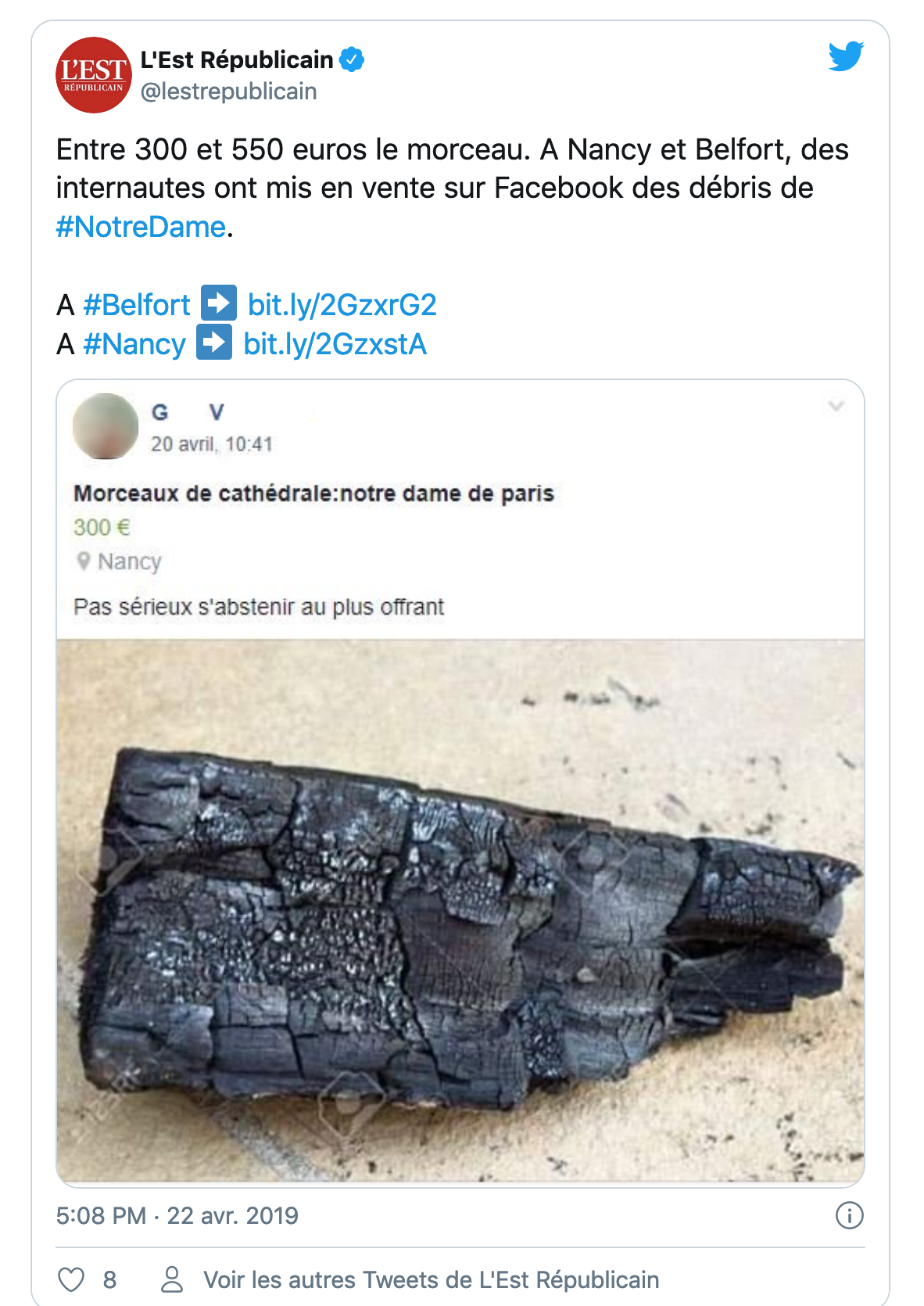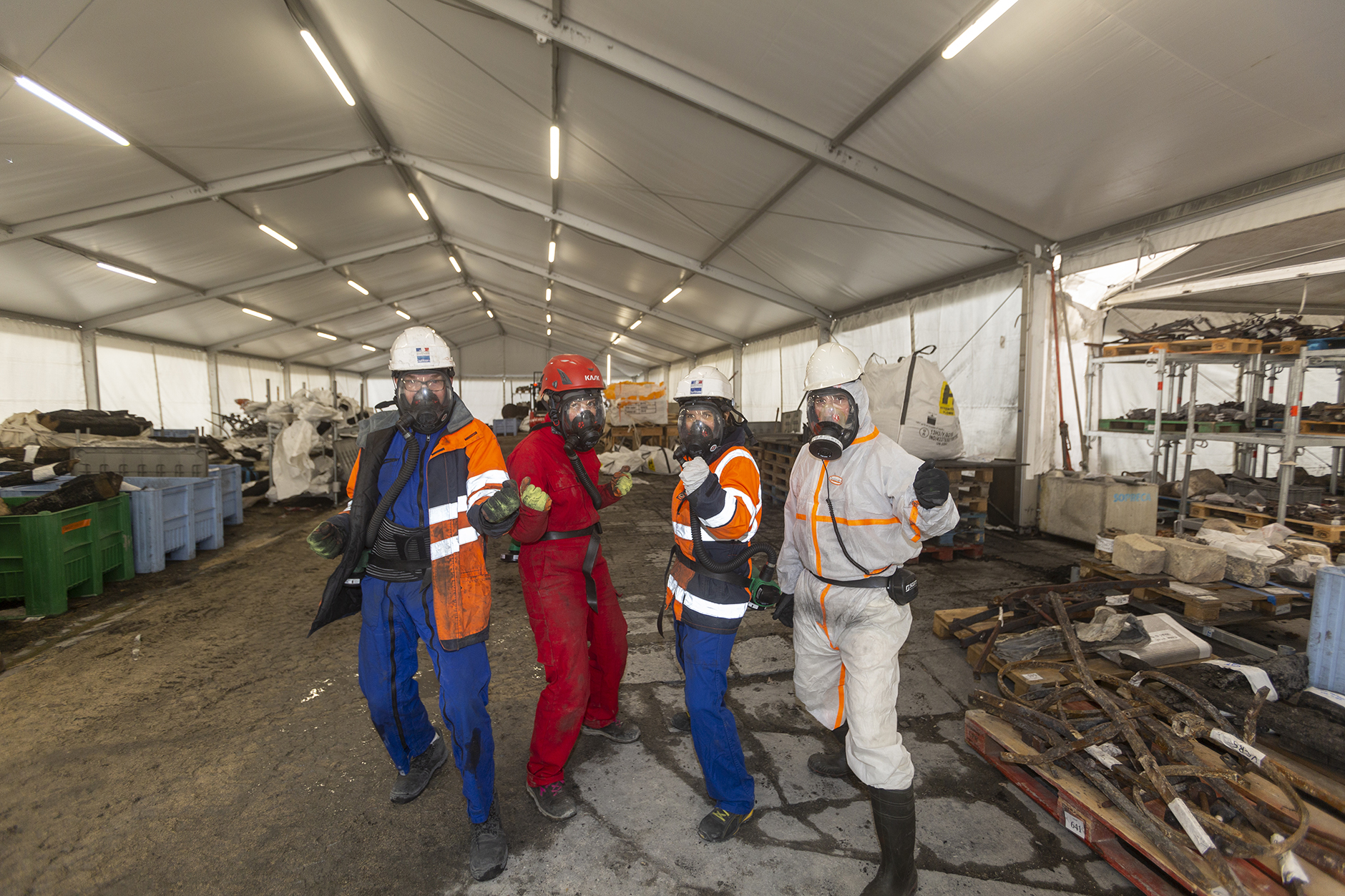Chapter 1 Heritage as a Memory

The cockerel of the spire of Notre-Dame exhibited at the Cité de l'Architecture et du Patrimoine. © Marie-Hélène Didier, 2020.
Gaspard Salatko
Should we commemorate the fire of Notre-Dame de Paris? And if so, then how? Answering these questions is not at all obvious. Since 15 April 2019, very different events have accompanied the restoration of the cathedral: religious or civil ceremonies to honor the building as well as its rescue and reconstruction; the activation of liturgical instruments; exhibitions highlighting the statues salvaged from the cathedral, and visits by official figures. While all of these events have a public character, they do not possess the same meaning for all of the people involved. Ways of remembering the fire are not univocal. Instead, they are based on distinct logics that depend on the meaning given to the building and the uses made of it. Two months after the fire, the Archbishop of Paris said a mass inside the cathedral. Organized without public but broadcast live, the celebration underlined the religious dimension of the building. It illustrated the ecclesiastical position that the memorial function of a church is to commemorate the founding episodes of Christianity. This perspective, however, is not necessarily shared by parishioners who are eager to express the emotion they experienced during the tragedy. For them, the sharing of their emotions involves the activation and, if necessary, the restoration of liturgical instruments, such as the church bells or the Crown of Thorns. These ephemeral commemorations resonate with the concerns expressed by heritage institutions, for whom the fire opens a new page in the history of the monument.
Chapter 2 Did You Say Relic?

Sale of a burnt piece of the Notre-Dame's frame. © L’Est Républicain, 22 avril 2019.

Procession of the relics of Saint Genevieve of Paris. Every January the relics of Saint Genevieve are carried from Saint-Etienne du Mont to Notre-Dame de Paris. © Gaspard Salatko, Fondation des Sciences du Patrimoine, janvier 2020.
Gaspard Salatko
After the fire, the cathedral received unusual requests from individuals who wished to own a piece of the rubble of the damaged building. Their motives varied widely, from wishing to incorporate fragments into artistic work or architectural project to materializing the memory of a personal relationship with the monument. These requests demonstrate that the general public's attachment to the cathedral extends far beyond the religious or national dimensions of the monument. As the cathedral's staff sometimes remind us, Notre-Dame's fame is due not only to the building's Gothic splendor but also to films such as Disney's The Hunchback of Notre-Dame which have contributed to making it a worldwide icon.
However, there is no question of giving Notre-Dame's rubble to those who asks for it. For the public administrators responsible for the cathedral, the post-fire rubble is not ordinary debris, but rather it constitutes the building's remnants. These remnants are the inalienable property of the State, which guarantees their preservation. The position of the Catholic Church is quite different. For this institution, the rubble of the cathedral's framework is no different from any other burned timber elements. To attribute any exceptionality to these remains would equate to establishing a misleading analogy with relics, which are material traces of Christian history and whose veneration follows ritually codified practices. Religious institutions and heritage ones therefore take different positions in celebrating the exceptionality of the building and giving meaning to the drama. Nevertheless, Notre-Dame's lovers continue to make requests that are sometimes far removed from these institutional logics, such as a student of applied arts who wanted to create a reliquary for preserving a fragment of the charred framework. The relics of some are not the relics of others.
Chapter 3 The Memory of the Site

Group photo of a team of rope access technicians. © Alexis Komenda, C2RMF, février 2021.

Laughing together after a hard day. © Alexis Komenda, C2RMF, janvier 2020.

Souvenir photos, even in the shower. © Alexis Komenda, C2RMF, juillet 2019.
Claudie Voisenat
The restoration site certainly poses technical challenges, but above all it is a collective human undertaking that links today’s men and women to the values, knowledge and know-how of the ancient builders. On site, each person is mindful of his or her presence, of the mark they are leaving on the place and its history, and of the work in progress. These photographs, films, drawings, writings and other testimonies constitute the memory and archive of this exceptional experience and its emotional intensity. The coming together of architects, scientists, rope access technicians, craftspeople, lead-work specialists, sasmen*, and others has created a community united by the work and by the constraints imposed by the exceptional security conditions of the post-fire site. These conditions are linked to fears about the building’s stability and concerns for the safety of those working there, but also to the lead pollution. Workers must protect themselves from lead poisoning by using foot-baths and airlocks on entry and exit from the site, by taking compulsory showers, by exchanging their civilian clothing for special undergarments and overalls that are provided on site, and by wearing ventilation mask in areas where risk of contamination is high. Entry onto the construction site takes the form of a highly codified ritual. The colors of workers’ clothing and helmets, as well as the logos that appear on them, make identify of the different trades possible, but because workers cannot always see one another’s faces, they have learned to identify individuals by their manner of walking. All of these details signify that one belongs to the construction site ‘family’, while occasional visitors are immediately identifiable by the disposable white overalls highlighted with strips of bright blue tape that they are given to wear.
* Sasmen: Persons responsible for the transition areas between the "clean" and "dirty" parts of the site that require special procedures and equipment for access. They ensure that these procedures are carried out correctly (showers for decontamination, wearing of special suits, and ventilation masks) and provide the necessary towels, underwear, etc. People are in contact with them as soon as they enter and leave the site.

